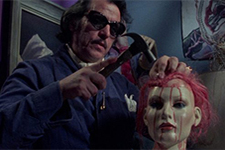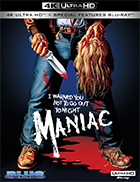Maniac (4K UHD)
|  William Lustig’s Maniac is as grisly and relentlessly single-minded as its title would suggest. An independently produced, low-budget guerilla cheapie destined for the grindhouses on 42nd Street, it stirred up a tornado of controversy wherever it went (starting with the Cannes Film Festival), not because it was anything particularly unique, but because it encapsulated so neatly and with such raw, uncompromised power the disturbing new trend in graphic horror violence—what some had termed “the new pornography”—that was decried by feminists as genuinely dangerous misogyny and by most everyone else as just plain sick. Of course, there was a large contingent of moviegoers in the early 1980s (as there are now) who were more than happy to turn Maniac into a substantial box-office hit, and its notoriety and immediately iconic poster image of a faceless man clutching a bloody knife in one hand and a recently removed scalp in the other all but ensured a long life on the emerging home video scene. Now that four decades have passed since Maniac first challenged the limits of what a horror film could show, we can see it more clearly for what it is: A film that is too good to be dismissed as simple exploitation, but also too inept in too many ways to be taken seriously. Unlike so many gory horror films of its era, Maniac makes no pretenses toward humor or self-reflexivity; it lacks the EC Comics-inspired irony of George A. Romero’s Dawn of the Dead (1978), the folkloric chills of John Carpenter’s Halloween (1978), and even the silly, campfire gotcha of Sean S. Cunningham’s Friday the 13th (1980), all of which were major hits among both horror fans and mainstream audiences. Maniac eschews such comforts, relying instead on a tone that is insistently grim and dour, its grainy 16mm images bathed in grime and colors that suggested nothing so much as looking out from inside bruised skin. It is a truly claustrophobic movie, and in that regard it must be afforded a certain level of respect if only for its unnerving effectiveness and commitment of vision. On the other hand, there are parts of the film that are amateurish, and much of its plotting is almost embarrassingly clumsy and sometimes downright nonsensical, even as it makes genuine stabs at putting us inside the mind of a serial killer. Its visceral impact is undeniable, but it lacks the kind of thematic rigor that would make its approach actually work. It is too grim to be fun, but too flawed to be truly appreciated. The film was the brainchild of Joe Spinell, a hard-boiled Italian-American character actor who had found success throughout the 1970s playing bit parts as heavies and hitmen in films like The Godfather (1972) and Rocky (1976). The screenplay, which he cowrote with C.A. Rosenberg, is a grab-bag mess of competently staged stalk-and-slash sequences that make generous use of make-up effects artist Tom Savini’s gift for realistically maiming the human body, whether by garret or knife or shotgun; intensely creepy sequences of Spinell’s character, a New York serial killer named Frank Zito, evincing his madness in the cluttered one-room apartment he shares with a bunch of mannequins adorned with the scalps of his victims; and a ludicrous subplot in which Frank becomes involved romantically with Anna (Caroline Munro), a beautiful fashion photographer who in real life would have nothing to do with the paunchy, pock-marked, socially inept Frank. The Frank/Anna subplot is easily the film’s weakest link, as it begs credulity on numerous levels, particularly that a woman as successful and articulate as Anna would see anything in Frank, who comes across as little more than a slovenly groupie, even when he cleans himself up and attempts to look presentable. Their relationship also adds nothing to our understanding of Frank, whose psychosis is apparently fueled by the violence inflicted on him by his mother, who he now sees in the face of every woman whose path he crosses. It is not surprising that feminist organizations found Maniac so repulsive, as it clearly blames Frank’s violence (and apparent hatred of women) on maternal abuse, although one doesn’t have to read too deeply into the film to recognize that it is hardly promoting violence against women, as only the most depraved viewer could possibly see Frank as a role model worthy of emulation. If anything, Spinell’s agitated, sweat-soaked performance is the film’s strongest asset, particularly the way he conveys Frank’s simultaneous self-loathing and unquenchable desire to satiate the demons of his past. The film’s most powerful sequences are the ones in which he loses control and then later berates himself (and his victim) for the subsequent violence. Interestingly, the film’s cautionary tagline—“I told you not to go out tonight”—was consistently misunderstood as a warning to women to “stay in their place,” when in fact it is a line of dialogue Frank speaks to himself, thus suggesting that he is internally divided over his activities, yet incapable of curtailing them. Unlike so many horror films of its era, Maniac appears to be making a genuine attempt to depict a more realistic monster—not a nightmare fantasy madman, but rather a traumatized character of some depth, which we see in the “conversations” he holds with himself and his mannequins. Director William Lustig, who had previously helmed a pair of X-rated films under the pseudonym Billy Bagg and would go on to direct Vigilante (1982), Maniac Cop (1988), and its sequels, embraces the film’s low budget and the necessity of handheld guerilla filmmaking techniques to contextualize Frank’s violence in the seediest corners of New York City, which has never looked like more of a cesspool of crime, corruption, and decay, especially with Jay Chattaway’s foreboding score layered over it. The pornographic movie theaters, streetwalkers, and dilapidated buildings that form the film’s backdrop suggest that Frank’s sickness is but an extreme example of a generally depraved culture, something the film’s critics would probably point out is made all the worse by movies like Maniac. They wouldn’t be wrong, but to dismiss Maniac as nothing more than morbid trash is to willfully ignore what it does well and how its attempts to get inside the mind of a serial killer, which is not that far removed from so much mainstream entertainment of today. In its own very scary way, Lustig’s little low-budget cheapie is one of the most prophetic movies of the early 1980s.
Copyright © 2020 James Kendrick Thoughts? E-mail James Kendrick All images copyright © Blue Underground | |||||||||||||||||||||||||||||||
Overall Rating: 

 (2.5)
(2.5)


